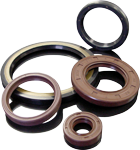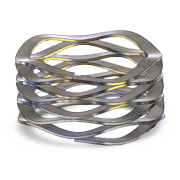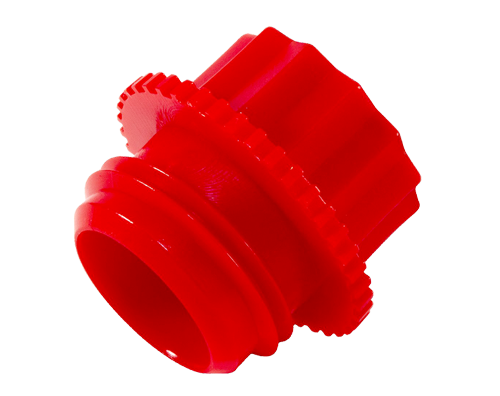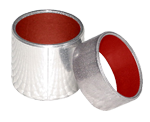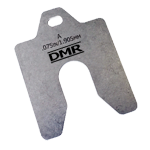Home >> Seal >>O-Rings >> Elastomers for Seals
Elastomers for Seals
(Standard Materials and Specifications)
A description and chart of the physical properties(temperature range, colour, hardness range) of the elastomers used in seals and o-rings
Nitrile Butadiene / Buna-N (NBR)
This compound has excellent resistance to a wide variety of fluids, good tensile strength, high elongation, low compression set, and excellent resistance to abrasion and tear. Most 0-Rings are made of this material due to its good physical and mechanical properties.
Nitrile is not recommended for exposure to di-ester, silicate ester, phosphate ester, hydraulic fluids, automotive brake fluid, acetates, ketones, aromatic fluids, ozone, sunlight, and weather. Good gasoline resistance, heat and abrasion resistance.
| Trade Name: | Chemigum®, NySyn, Hycar®, Paracril®, Kyrnac® |
| Temperature Range: | -65° F to 250° F |
| Usual Colour: | Black |
| Usual Hardness Range: | 50-90 Shore A |
Silicone (SI)
This compound has excellent resistance to temperature extremes and excellent dry heat resistance. It has good resistance to sunlight, ozone, weathering, and has moderate oil resistance.
Silicone is not recommended for exposure to petroleum fluids, and ketones. It is also not recommended where physical strength or abrasion resistance is required, since it has poor tensile and tear strength.
| Trade Name: | Silastic®, Thermoflex™ |
| Temperature Range: | -80° F to 450° F |
| Usual Colour: | Red, Blue, Yellow |
| Usual Hardness Range: | 50-90 Shore A |
Fluorocarbon (FKM, FMC)
This compound has excellent resistance to a wide range of chemicals, excellent high temperature stability, excellent resistance to petroleum products, good resistance to weathering, ozone, oxygen, high temperature and flame, low compression set, low gas permeability, and is good for hard vacuum service.
Fluorocarbon is not recommended for exposure to ketones, esters, anhydrous ammonia, and fire resistant fluids such as Skydrol, hot hydrofluoric, chlorosulonic acid, hot water/steam, and/or brake fluid.
| Trade Name: | Viton®, Fluorel® |
| Temperature Range: | -31° F to 437° F |
| Usual Colour: | Black, Brown, Green |
| Usual Hardness Range: | 60-95 Shore A |
Hydrogenated Acrylonitrile Butadiene (HNBR, HSN)
Hydrogenated Acrylonitrile Butadiene (HNBR), also known as Highly Saturated Nitrile (HSN) is superior to NBR in low brittle temperature, heat, oil, oil additive and sour oil resistance, and is far more resistant to sour gasoline and ozone than NBR.
HNBR is ideal for industrial products normally made of NBR, and can be used in more severe conditions with much longer service life. This compound is extensively used in R-134A cooling systems. HNBR is not recommended for exposure to ketones, esters, ethers, and aromatic fluids.
| Trade Name: | Therban®, Zetpol®, Tornac |
| Temperature Range: | -40° F to 300° F |
| Usual Colour: | Green, Black |
| Usual Hardness Range: | 60-80 Shore A |
Chloroprene (CR)
This compound has excellent resistance to refrigerants, ozone, oxygen, sunlight, and weathering, good resistance to heat and flame, fair resistance to oil, resists flexing and stain, and has low compression set.
Chloroprene is not recommended for exposure to water, phosphate, esters, aromatic hydrocarbons, chlorinated solvents, and ketones.
Good resistance to cold and voltage, applied to general commodities.
| Trade Name: | Neoprene® |
| Temperature Range: | -65° F to 275° F |
| Usual Colour: | Black |
| Usual Hardness Range: | 50-90 Shore A |
Ethylene Propylene (EPDM)
This compound has high tensile strength, elongation, good low temperature flexibility, outstanding heat aging, good electrical properties, excellent resistance to water, steam, acids, alkalis, ketones, Skydrol, phosphate, oxygen, weathering, ozone, and brake fluid.
Ethylene propylene is not recommended for exposure to petroleum oils and solvents, and di-ester base lubricants.
Good brake oil resistance, excellent heat resistance.
| Trade Name: | Vistalon®, Epsyn®, Fpcar, Royalene®, Nordel® |
| Temperature Range: | -80° F to 300° F |
| Usual Colour: | Red, Black, Yellow |
| Usual Hardness Range: | 50-90 Shore A |
Styrene Butadiene / Buna-S (SBR)
This compound is a low cost and high volume rubber; it can be compounded into materials with high tensile strength, high modulus, and high hardness without the use of large amount of fillers; it has good abrasion resistance, and when it is a low styrene and high butadiene compound, it has good flexibility at low temperature.
Styrene butadiene is not recommended for exposure to solvents, oils, dieter lubricants, and aromatic hydrocarbons.
| Trade Name: | GRS |
| Temperature Range: | -40° F to 212° F |
| Usual Colour: | Black |
| Usual Hardness Range: | 70-90 Shore A |
Fluorosilicone (FSI, FVMQ)
This compound has the general characteristics for silicone, with excellent resistance to petroleum oils, solvent, hydrocarbon fuels, ozone, and weathering; it also has good low temperature flexibility, low compression set and good electrical properties.
| Trade Name: | Silastic® LS, FSE |
| Temperature Range: | -85° F to 350° F |
| Usual Colour: | Light Blue |
| Usual Hardness Range: | 50-90 Shore A |
Perfluoroelastomers (FFKM)
This product is available in standard AS568 sizes, metric sizes as well as custom molds and extrusions. Providing flexibility, chemical resistance, and High Temperature characteristics this is the Material of Choice for Critical Sealing applications.
View our Kalrez Compounds section for compound specific properties.
Kalrez Spectrum 6375 Data Sheet
Kalrez Spectrum 7075 Data Sheet
Kalrez 4079 Data Sheet
Kalrez 1050LF Data Sheet
| Trade Name: | Kalrez®, |
| Temperature Range: | -31° F to 600° F |
| Usual Colour: | Black, White |
| Usual Hardness Range: | 75 Shore A |
TFE Elastomer (AFLAS)
This compound provides an advantageous combination of high temperature, chemical and electrical resistance properties. It is different from fluoroelastomers such as FKM (FPM) types because of its unique composition (tetrafluoroethylene/propylene copolymer). As a result, TFE Elastomers can provide service advantages in many chemicals, as well as in electrical applications.
| Trade Name: | Aflas™ |
| Temperature Range: | -40° F to 400° F |
| Usual Colour: | Red, Blue, Yellow, Black |
| Usual Hardness Range: | 50-90 Shore A |
Polyurethane (AU, EU)
Polyurethane elastomers, as a class, have excellent wear resistance, high tensile strength and high elasticity in comparison with any other elastomers. Permeability is good and comparable with butyl. The inherent toughness and abrasion resistance of polyurethane seals is particularly desirable in hydraulic systems where high pressure, shock loads, wide metal tolerances, or abrasive contamination is anticipated.
| Trade Name: | Vibrathane™, Cyanaprene, Polathane, Adiprene, Disogrin, Elastothane, Formez, Pellethane |
| Temperature Range: | -60° F to 200° F |
| Usual Colour: | Amber |
| Usual Hardness Range: | 70-90 Shore A |


